How to Add Leading Zeros in Excel?
Leading Zeros in Excel, your key to numerical precision and data integrity, empowers you to manage and present information with the utmost accuracy. This essential feature ensures that your data, especially numeric codes or identifiers, maintains its intended format without losing leading zeros. Seamlessly navigating through Excel, you can rely on ‘Leading Zeros in Excel’ to preserve the integrity of your information, allowing for meticulous record-keeping and enhancing the overall reliability of your spreadsheets. Embrace this indispensable tool to confidently organize and display numerical data, transforming your Excel experience into a seamless journey of precision and clarity.
A leading zero is a digit zero that comes before the first non-digit zero.
This tutorial covers:
- Use the TEXT Function to add leading zeros
- Adding zeros through the CUSTOM Number Format
- Add Leading Zeros Using REPT and LEN function
- Add Leading Zeros Using ‘Format to Text’
- Removing leading zeros
Excel add leading zeros.
1. Using Excel with the TEXT Function to Add Leading Zeros
The TEXT capability will allow you to apply a custom format option to any number in Excel.
= TEXT (Value, Format)
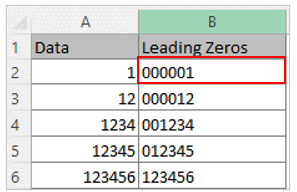
Type in your target cell
= TEXT (A2, “000000”)
So, if you wanted to add zeros in front of a number in cell B2 and the total number of digits are 6, now you can use the above formula.
2. Adding Zeros through the CUSTOM Number format – using custom format
To add leading zeros with the sample data, we copied the same data to column B
Then select the data and press CTRL+1 to pop up the Format Cells window
From Format Cells window select Custom category under Number menu
Write your desired zeros (6 in our example) in the Type space
Press Ok to add leading zeros.
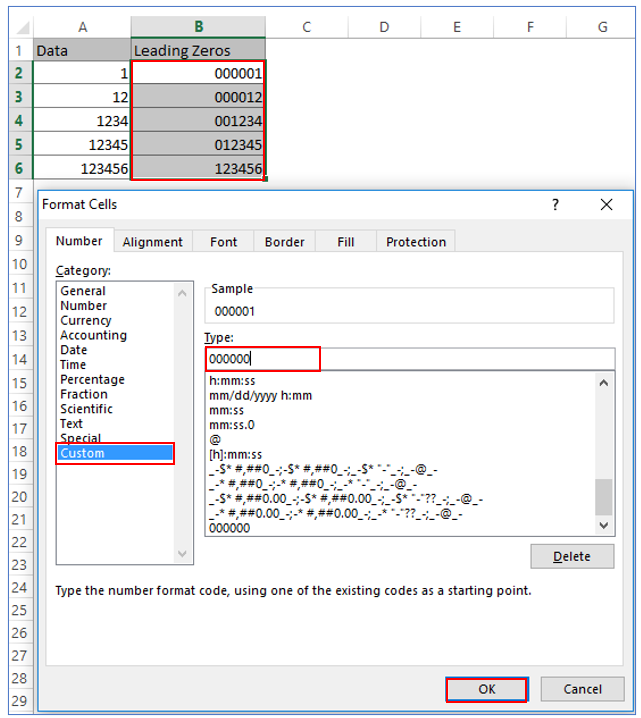
3. Keep Leading Zeros Using REPT and LEN function
One more method for embedding driving zeros preceding a text string in Excel is utilizing this mix of REPT and LEN capabilities:
REPT (0, number of zeros-LEN (cell)) &cell
For instance, to add driving zeroes to the worth in A2 to make a 6-character string, this recipe goes as follows:
=REPT (0, 6-LEN(A2)) &A2
The way these functions:
Realizing that the REPT capability rehashes a provided character a predefined number of times, and LEN returns the complete length of the string, the equation’s rationale is straightforward:
LEN(A2) gets the complete number of characters in cell A2.
REPT (0, 6-LEN(A2)) adds the necessary number of zeros. To work out the number of zeros that ought to be added, you remove the length of the string in A2 from the most extreme number of zeros.
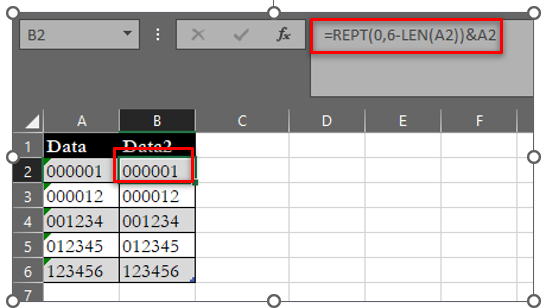
Main concern: This equation can add driving zeros both to numbers and text strings, yet the outcome is generally text, not a number.
4. Add Leading Zeros Using Format to Text
In Excel, changing the cell format to “Text” can help you add leading zeros to numbers and make them appear exactly as typed. Here’s how to do it:
- Select Cells: Click and drag to select the cells where you want to add leading zeros.
- Format Cells: Right-click on the selected area and choose ‘Format Cells’ from the context menu, or go to the Home tab, click on the Number format dropdown (where it likely says ‘General’ or another format), and choose ‘More Number Formats’ at the bottom.
- Text Format: In the Format Cells window, under the Number tab, select ‘Text’ from the list of categories on the left side.
- Enter Data: Click ‘OK’ to apply the text format. Now, when you type numbers into these cells, Excel will not remove leading zeros. For example, typing ‘00123’ will keep it as ‘00123’.
- Adding Zeros to Existing Data: If you have existing data, convert it to text following steps 1-3, then retype the numbers or use a formula like
=TEXT(A1,"00000")(assuming A1 is your original number and you want to ensure five digits including leading zeros), then copy and paste this as values.
How to Remove Leading Zeros in Excel?
1. Convert the Text to Number using the Error Checking Option
This is presumably the most straightforward strategy to dispose of driving zeros.
Here, we have an informational index with the numbers that have punctuation before these and the leading zeros. This explains why these numbers are adjusted to the left (while naturally, numbers adjust to the right) and have the leading 0’s.

That is all there is to it! The above advances would eliminate the apostrophe and convert the text values into numbers.
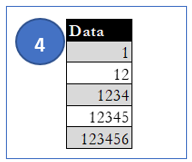
2. VALUE function
One more fast and straightforward technique to eliminate the leading zeros is to utilize the worth capability.
Let’s take below data as example:
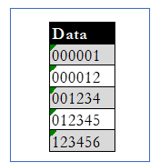
In below this is the formula that would remove the leading zeros
= VALUE(A2)
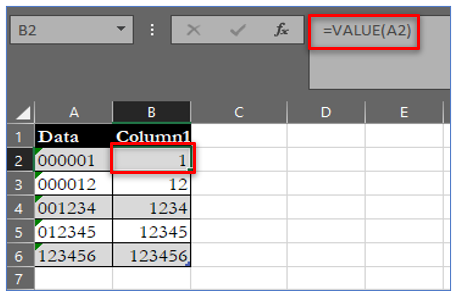
Application of ‘Add Leading Zeros’ in Excel
- Product Codes and SKUs:
- Preserve leading zeros in product codes or stock-keeping unit (SKU) numbers to ensure consistent and accurate identification, preventing data discrepancies.
- Employee or Student IDs:
- Maintain the correct format of employee or student IDs with leading zeros, preventing the unintentional removal of zeros and guaranteeing accurate identification.
- Zip Codes and Postal Codes:
- Safeguard leading zeros in zip codes or postal codes to accurately represent geographic locations, preventing errors in address data entry.
- Numeric Codes in Data Analysis:
- When conducting data analysis or creating lookup tables, leading zeros ensure that numeric codes are correctly matched and referenced, preventing misinterpretation of data.
- Accounting and Financial Data:
- Use leading zeros in accounting or financial data, such as account numbers or transaction codes, to maintain precision in calculations and financial reporting.
- Date and Time Formats:
- Preserve leading zeros in date and time formats, ensuring consistency and preventing issues with sorting or filtering chronological data in Excel.
Maintaining leading zeros is crucial for accurate identification and representation of data, particularly in scenarios where specific formats are essential for proper functioning and interpretation.
For ready-to-use Dashboard Templates:
